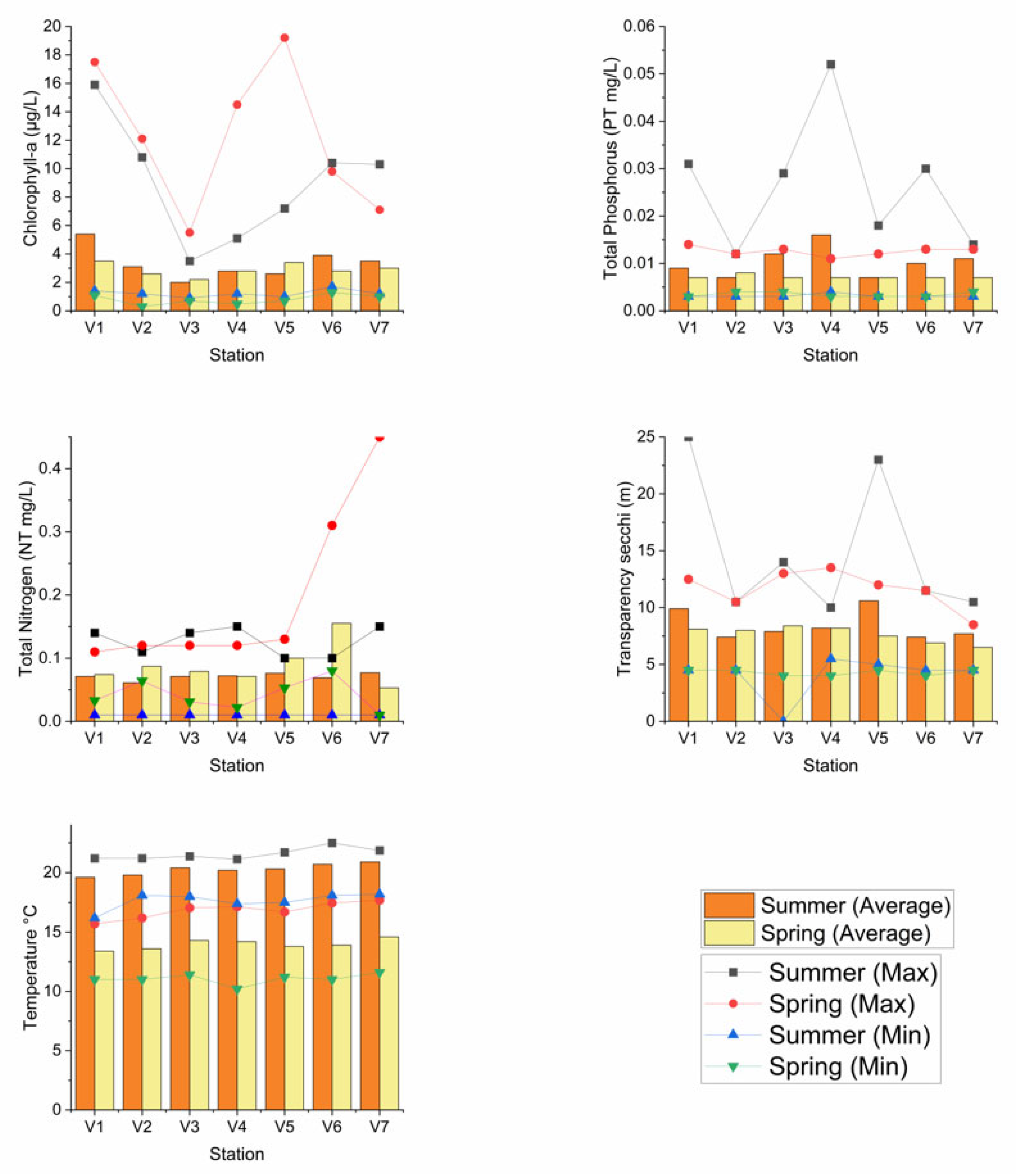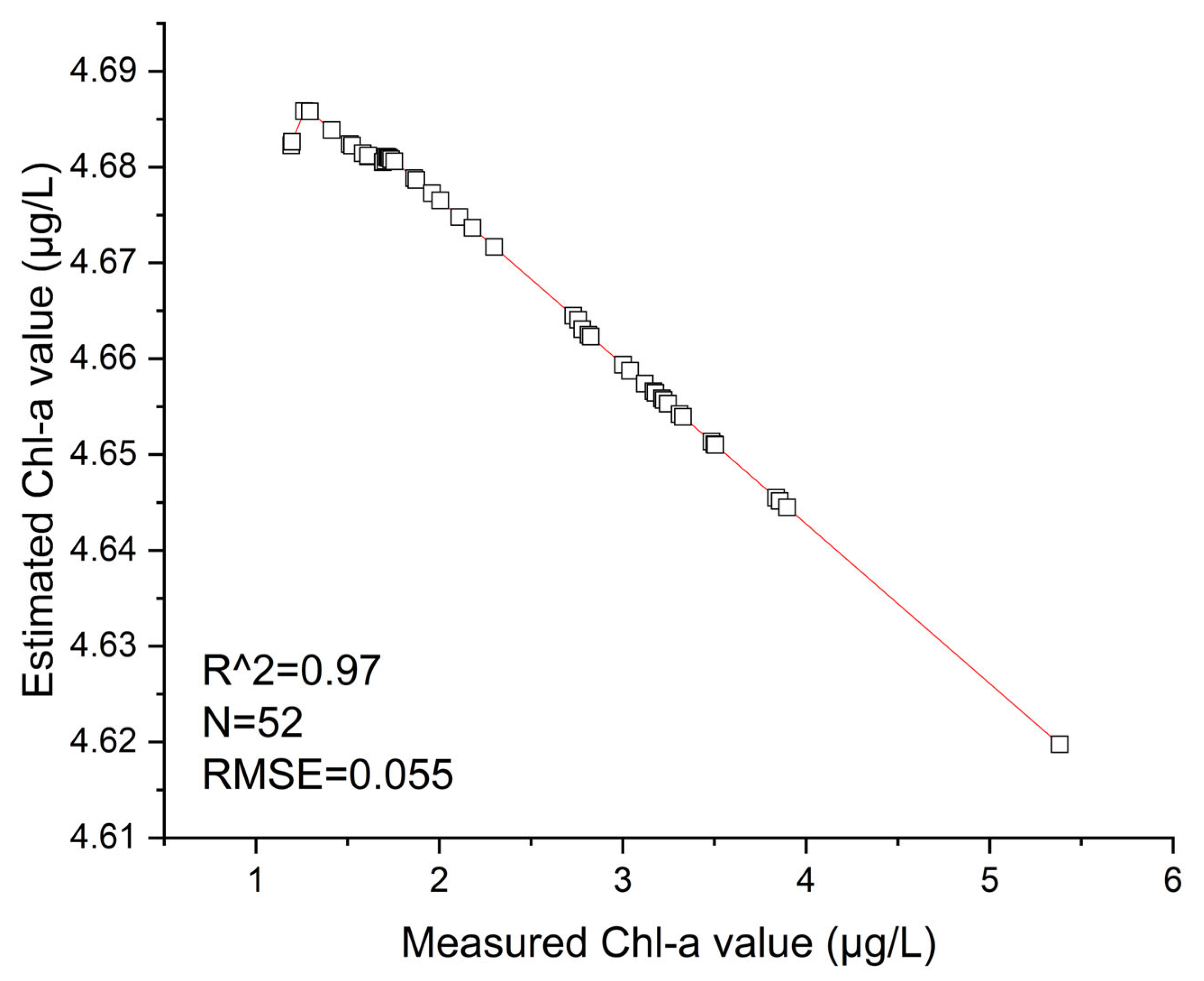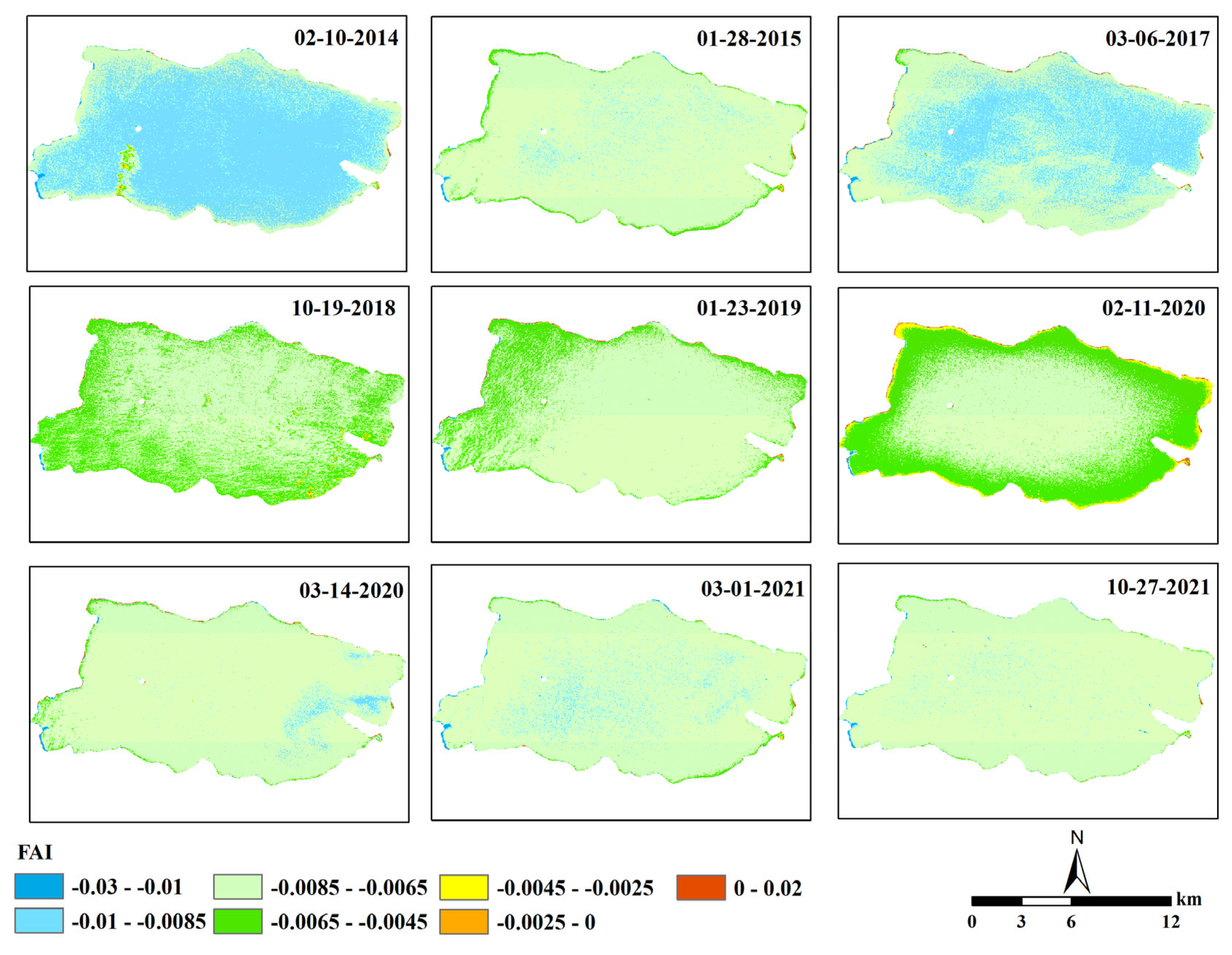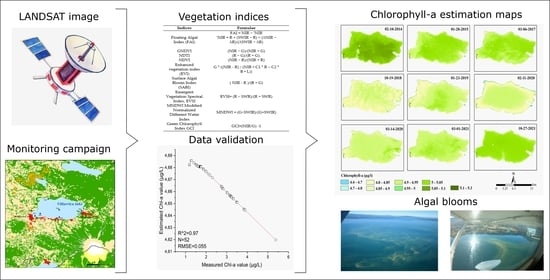Recovery of Water Quality and Detection of Algal Blooms in Lake Villarrica through Landsat Satellite Images and Monitoring Data
Abstract
:1. Introduction
2. Materials and Methods
2.1. Research Area
2.2. Field Data Collection
2.3. Raw Satellite Images
2.4. Spectral Indices
2.5. Statistical Analysis
Algorithms for Chlorophyll-a Estimation and Mapping
3. Results
3.1. Water Quality Parameters
3.2. Estimation Model/Statistics
3.3. Bloom Estimation Maps
3.4. Evolution of Algal Blooms in Lake Villarrica
4. Discussion
5. Conclusions
Supplementary Materials
Author Contributions
Funding
Data Availability Statement
Acknowledgments
Conflicts of Interest
References
- Carpenter, S.R.; Stanley, E.H.; vander Zanden, M.J. State of the World’s Freshwater Ecosystems: Physical, Chemical, and Biological Changes. Annu. Rev. Environ. Resour. 2011, 36, 75–99. [Google Scholar] [CrossRef] [Green Version]
- Ho, L.T.; Goethals, P.L.M. Opportunities and Challenges for the Sustainability of Lakes and Reservoirs in Relation to the Sustainable Development Goals (SDGs). Water 2019, 11, 1462. [Google Scholar] [CrossRef] [Green Version]
- Gozlan, R.E.; Karimov, B.K.; Zadereev, E.; Kuznetsova, D.; Brucet, S. Status, Trends, and Future Dynamics of Freshwater Ecosystems in Europe and Central Asia. Inland Waters 2019, 9, 78–94. [Google Scholar] [CrossRef]
- Kumar, R.; Parvaze, S.; Huda, M.B.; Allaie, S.P. The Changing Water Quality of Lakes—A Case Study of Dal Lake, Kashmir Valley. Environ. Monit. Assess. 2022, 194, 228. [Google Scholar] [CrossRef] [PubMed]
- Irannezhad, M.; Ahmadi, B.; Liu, J.; Chen, D.; Matthews, J.H. Global Water Security: A Shining Star in the Dark Sky of Achieving the Sustainable Development Goals. Sustain. Horiz. 2022, 1, 100005. [Google Scholar] [CrossRef]
- Prado, R.; García, R.; Rioboo, C.; Herrero, C.; Cid, A. Suitability of Cytotoxicity Endpoints and Test Microalgal Species to Disclose the Toxic Effect of Common Aquatic Pollutants. Ecotoxicol. Environ. Saf. 2015, 114, 117–125. [Google Scholar] [CrossRef] [Green Version]
- Park, J.; Kim, K.T.; Lee, W.H. Recent Advances in Information and Communications Technology (ICT) and Sensor Technology for Monitoring Water Quality. Water 2020, 12, 510. [Google Scholar] [CrossRef] [Green Version]
- Ostroumov, S.A. Water Quality and Conditioning in Natural Ecosystems: Biomachinery Theory of Self-Purification of Water. Russ. J. Gen. Chem. 2017, 87, 3199–3204. [Google Scholar] [CrossRef]
- Demetillo, A.T.; Taboada, E.B. Real-Time Water Quality Monitoring for Small Aquatic Area Using Unmanned Surface Vehicle. Technol. Appl. Sci. Res. 2019, 9, 3959–3964. [Google Scholar] [CrossRef]
- Rodríguez-López, L.; González-Rodríguez, L.; Duran-Llacer, I.; Cardenas, R.; Urrutia, R. Spatio-Temporal Analysis of Chlorophyll in Six Araucanian Lakes of Central-South Chile from Landsat Imagery. Ecol. Inform. 2021, 65, 101431. [Google Scholar] [CrossRef]
- Peterson, K.T.; Sagan, V.; Sidike, P.; Hasenmueller, E.A.; Sloan, J.J.; Knouft, J.H. Machine Learning-Based Ensemble Prediction of Water-Quality Variables Using Feature-Level and Decision-Level Fusion with Proximal Remote Sensing. Photogramm. Eng. Remote Sens. 2019, 85, 269–280. [Google Scholar] [CrossRef]
- Rodríguez-López, L.; Duran-Llacer, I.; González-Rodríguez, L.; Abarca-del-Rio, R.; Cárdenas, R.; Parra, O.; Martínez-Retureta, R.; Urrutia, R. Spectral Analysis Using LANDSAT Images to Monitor the Chlorophyll-a Concentration in Lake Laja in Chile. Ecol. Inform. 2020, 60, 101183. [Google Scholar] [CrossRef]
- Aranda, A.C.; Rivera-Ruiz, D.; Rodríguez-López, L.; Pedreros, P.; Arumí-Ribera, J.L.; Morales-Salinas, L.; Fuentes-Jaque, G.; Urrutia, R. Evidence of Climate Change Based on Lake Surface Temperature Trends in South Central Chile. Remote Sens. 2021, 13, 4535. [Google Scholar] [CrossRef]
- Bhagowati, B.; Ahamad, K.U. A Review on Lake Eutrophication Dynamics and Recent Developments in Lake Modeling. Ecohydrol. Hydrobiol. 2019, 19, 155–166. [Google Scholar] [CrossRef]
- Zou, R.; Wu, Z.; Zhao, L.; Elser, J.J.; Yu, Y.; Chen, Y.; Liu, Y. Seasonal Algal Blooms Support Sediment Release of Phosphorus via Positive Feedback in a Eutrophic Lake: Insights from a Nutrient Flux Tracking Modeling. Ecol. Model. 2020, 416, 108881. [Google Scholar] [CrossRef]
- Harrison, J.W.; Smith, R.E.H. Environmental Effects of UV Radiation Effects of Ultraviolet Radiation on the Productivity and Composition of Freshwater Phytoplankton Communities. Photochem. Photobiol. Sci. 2009, 8, 1218–1232. [Google Scholar] [CrossRef]
- Nazari-Sharabian, M.; Ahmad, S.; Karakouzian, M. Climate Change and Eutrophication: A Short Review. Eng. Technol. Appl. Sci. Res. 2018, 8, 3668–3672. [Google Scholar] [CrossRef]
- Berg, M.; Sutula, M. Factors Affecting Growth of Cyanobacteria with Special Emphasis on the Sacramento-San Joaquin Delta EXECUTIVE SUMMARY. In Southern California Coastal Water Research Project Technical Report; Southern California Coastal Water Research Project: Costa Mesa, CA, USA, 2015; Volume 869, p. 100. [Google Scholar]
- Li, S.; Song, K.; Wang, S.; Liu, G.; Wen, Z.; Shang, Y.; Lyu, L.; Chen, F.; Xu, S.; Tao, H.; et al. Quantification of Chlorophyll-a in Typical Lakes across China Using Sentinel-2 MSI Imagery with Machine Learning Algorithm. Sci. Total Environ. 2021, 778, 146271. [Google Scholar] [CrossRef]
- Lillesand, T.; Kiefer, R.W.; Chipman, J. Remote Sensing and Image Interpretation; John Wiley & Sons.: Hoboken, NJ, USA, 2015; ISBN 978-1-118-34328-9. [Google Scholar]
- Gholizadeh, M.H.; Melesse, A.M.; Reddi, L. A Comprehensive Review on Water Quality Parameters Estimation Using Remote Sensing Techniques. Sensors 2016, 16, 1298. [Google Scholar] [CrossRef] [Green Version]
- Qing, S.; Runa, A.; Shun, B.; Zhao, W.; Bao, Y.; Hao, Y. Distinguishing and Mapping of Aquatic Vegetations and Yellow Algae Bloom with Landsat Satellite Data in a Complex Shallow Lake, China during 1986–2018. Ecol. Indic. 2020, 112, 106073. [Google Scholar] [CrossRef]
- Elhag, M.; Gitas, I.; Othman, A.; Bahrawi, J.; Gikas, P. Assessment of Water Quality Parameters Using Temporal Remote Sensing Spectral Reflectance in Arid Environments, Saudi Arabia. Water 2019, 11, 556. [Google Scholar] [CrossRef] [Green Version]
- Ma, J.; Jin, S.; Li, J.; He, Y.; Shang, W. Spatio-Temporal Variations and Driving Forces of Harmful Algal Blooms in Chaohu Lake: A Multi-Source Remote Sensing Approach. Remote Sens. 2021, 13, 427. [Google Scholar] [CrossRef]
- Alawadi, F. Detection of Surface Algal Blooms Using the Newly Developed Algorithm Surface Algal Bloom Index (SABI). In Remote Sensing of the Ocean, Sea Ice, and Large Water Regions 2010; SPIE: St Bellingham, WA, USA, 2010; Volume 7825, p. 782506. [Google Scholar] [CrossRef] [Green Version]
- Boucher, J.; Weathers, K.C.; Norouzi, H.; Steele, B. Assessing the Effectiveness of Landsat 8 Chlorophyll a Retrieval Algorithms for Regional Freshwater Monitoring. Ecol. Appl. 2018, 28, 1044–1054. [Google Scholar] [CrossRef] [Green Version]
- Xu, J.; Liu, H.; Lin, J.; Lyu, H.; Dong, X.; Li, Y.; Guo, H.; Wang, H. Long-Term Monitoring Particulate Composition Change in the Great Lakes Using MODIS Data. Water Res. 2022, 222, 118932. [Google Scholar] [CrossRef]
- Lekki, J.; Deutsch, E.; Sayers, M.; Bosse, K.; Anderson, R.; Tokars, R.; Sawtell, R. Determining Remote Sensing Spatial Resolution Requirements for the Monitoring of Harmful Algal Blooms in the Great Lakes. J. Great Lakes Res. 2019, 45, 434–443. [Google Scholar] [CrossRef]
- Sayers, M.J.; Grimm, A.G.; Shuchman, R.A.; Bosse, K.R.; Fahnenstiel, G.L.; Ruberg, S.A.; Leshkevich, G.A. Satellite Monitoring of Harmful Algal Blooms in the Western Basin of Lake Erie: A 20-Year Time-Series. J. Great Lakes Res. 2019, 45, 508–521. [Google Scholar] [CrossRef]
- Cazzaniga, I.; Zibordi, G.; Mélin, F. Spectral Features of Ocean Colour Radiometric Products in the Presence of Cyanobacteria Blooms in the Baltic Sea. Remote Sens. Environ. 2023, 287, 113464. [Google Scholar] [CrossRef]
- Vaičiūtė, D.; Bučas, M.; Bresciani, M.; Dabulevičienė, T.; Gintauskas, J.; Mėžinė, J.; Tiškus, E.; Umgiesser, G.; Morkūnas, J.; de Santi, F.; et al. Hot Moments and Hotspots of Cyanobacteria Hyperblooms in the Curonian Lagoon (SE Baltic Sea) Revealed via Remote Sensing-Based Retrospective Analysis. Sci. Total Environ. 2021, 769, 145053. [Google Scholar] [CrossRef] [PubMed]
- Nimptsch, J.; Woelfl, S.; Osorio, S.; Valenzuela, J.; Moreira, C.; Ramos, V.; Castelo-Branco, R.; Leão, P.N.; Vasconcelos, V. First Record of Toxins Associated with Cyanobacterial Blooms in Oligotrophic North Patagonian Lakes of Chile-a Genomic Approach. Int. Rev. Hydrobiol. 2016, 101, 57–68. [Google Scholar] [CrossRef]
- Publicación, F.; Santiago, N. 19-Establece Normas Secundarias de Calidad Ambiental Para la Protección de Las Aguas Continentales Superficiales del lago Villarrica Ministerio del Medio Ambiente Establece Normas Secundarias de Calidad Ambiental Para la Protección de Las Aguas Continentales Superficiales del lago Villarrica; MEDIO: Mar del Plata, Argentina, 2013; Volume 19. [Google Scholar]
- Wojtiuk, J.R.; Otero, A.M. Condominiums: Indicators of Post-Tourism Change. The Case of Pucon, Chile. In Realidad, Tendencias y Desafíos en Turismo; Consejo de Decanos y Directores de Unidades Académicas Relacionadas con la Enseñanza del Turismo: Neuquén, Argentina, 2020; Volume 18, pp. 53–73. [Google Scholar]
- Vergara, L.; Sánchez, C.; Zunino, H.M. Lifestyle Migration: Creating Diverse and Cohesive Communities? The Case of Los Riscos, Pucón, Chile. Rev. Austral Cienc. Soc. 2019, 36, 47–67. [Google Scholar] [CrossRef]
- Rodríguez-López, L.; González-Rodríguez, L.; Duran-Llacer, I.; García, W.; Cardenas, R.; Urrutia, R. Assessment of the Diffuse Attenuation Coefficient of Photosynthetically Active Radiation in a Chilean Lake. Remote Sens. 2022, 14, 4568. [Google Scholar] [CrossRef]
- Niemeyer, H. Hoyas Hidrográficas De Chile Novena Región; Dirección General de Aguas: Santiago, Chile, 1980. [Google Scholar]
- Campos, H.; Steffen, W.; Roman, C.; Zúñiga, L.; Aguero, G. Limnological Studies in Lake Villarrica Morphometric, Physical, Chemical, Planktonical Factors and Primary Productivity. Arch. Hydrobiologie. Supplementband. Monogr. Beiträge 1983, 65, 371–406. [Google Scholar]
- DGA Atlas Del Agua. Atlas del Agua Chile 2016; Ministerio de Obras Públicas: Santiago, Chile, 2016; Volume 1, pp. 1–24. [Google Scholar]
- Ilori, C.O.; Pahlevan, N.; Knudby, A. Analyzing Performances of Different Atmospheric Correction Techniques for Landsat 8: Application for Coastal Remote Sensing. Remote Sens. 2019, 11, 469. [Google Scholar] [CrossRef] [Green Version]
- Vanhellemont, Q.; Ruddick, K. Atmospheric Correction of Metre-Scale Optical Satellite Data for Inland and Coastal Water Applications. Remote Sens. Environ. 2018, 216, 586–597. [Google Scholar] [CrossRef]
- Vanhellemont, Q. Adaptation of the Dark Spectrum Fitting Atmospheric Correction for Aquatic Applications of the Landsat and Sentinel-2 Archives. Remote Sens. Environ. 2019, 225, 175–192. [Google Scholar] [CrossRef]
- Vanhellemont, Q. Sensitivity Analysis of the Dark Spectrum Fitting Atmospheric Correction for Metre- and Decametre-Scale Satellite Imagery Using Autonomous Hyperspectral Radiometry. Opt. Express 2020, 28, 29948. [Google Scholar] [CrossRef]
- Vanhellemont, Q.; Ruddick, K. Turbid Wakes Associated with Offshore Wind Turbines Observed with Landsat 8. Remote Sens. Environ. 2014, 145, 105–115. [Google Scholar] [CrossRef] [Green Version]
- Vanhellemont, Q.; Ruddick, K. Advantages of High Quality SWIR Bands for Ocean Colour Processing: Examples from Landsat-8. Remote Sens. Environ. 2015, 161, 89–106. [Google Scholar] [CrossRef] [Green Version]
- Vanhellemont, Q.; Ruddick, K. Acolite for Sentinel-2: Aquatic Applications of MSI Imagery. In Proceedings of the 2016 ESA Living Planet Symposium, Prague, Czech Republic, 9–13 May 2016; Praga: Prague, Czechia, 2016; pp. 9–13. [Google Scholar]
- Rodríguez-López, L.; Duran-Llacer, I.; González-Rodríguez, L.; Cardenas, R.; Urrutia, R. Retrieving Water Turbidity in Araucanian Lakes (South-Central Chile) Based on Multispectral Landsat Imagery. Remote Sens. 2021, 13, 3133. [Google Scholar] [CrossRef]
- DGA Dirección General de Aguas de Chile. Available online: https://dga.mop.gob.cl/ (accessed on 2 March 2023).
- Verstraete, M.M.; Pinty, B. Verstraete1996. IEEE Trans. Geosci. Remote Sens. 1996, 34, 1254–1265. [Google Scholar] [CrossRef]
- Shi, K.; Zhang, Y.; Qin, B.; Zhou, B. Remote Sensing of Cyanobacterial Blooms in Inland Waters: Present Knowledge and Future Challenges. Sci. Bull. 2019, 64, 1540–1556. [Google Scholar] [CrossRef] [PubMed] [Green Version]
- Huete, A.; Didan, K.; Miura, T.; Rodriguez, E.P.; Gao, X.; Ferreira, L.G. Overview of the Radiometric and Biophysical Performance of the MODIS Vegetation Indices. Remote Sens. Environ. 2002, 83, 195–213. [Google Scholar] [CrossRef]
- Hu, C. A Novel Ocean Color Index to Detect Floating Algae in the Global Oceans. Remote Sens. Environ. 2009, 113, 2118–2129. [Google Scholar] [CrossRef]
- Gitelson, A.A.; Kaufman, Y.J.; Merzlyak, M.N.; Blaustein, J. Use of a Green Channel in Remote Sensing of Global Vegetation from EOS-MODIS. Remote Sens. Environ. 1996, 58, 289–298. [Google Scholar] [CrossRef]
- Duran-Llacer, I.; Arumí, J.L.; Arriagada, L.; Aguayo, M.; Rojas, O.; González-Rodríguez, L.; Rodríguez-López, L.; Martínez-Retureta, R.; Oyarzún, R.; Singh, S.K. A New Method to Map Groundwater-Dependent Ecosystem Zones in Semi-Arid Environments: A Case Study in Chile. Sci. Total Environ. 2022, 816, 151528. [Google Scholar] [CrossRef]
- Xu, H. A Study on Information Extraction of Water Body with the Modified Normalized Difference Water Index (MNDWI). J. Remote Sens. 2005, 9, 589–595. [Google Scholar]
- Hassan, M.A.; Yang, M.; Rasheed, A.; Jin, X.; Xia, X.; Xiao, Y.; He, Z. Time-Series Multispectral Indices from Unmanned Aerial Vehicle Imagery Reveal Senescence Rate in Bread Wheat. Remote Sens. 2018, 10, 809. [Google Scholar] [CrossRef] [Green Version]
- Gitelson, A.A.; Viña, A.; Ciganda, V.; Rundquist, D.C.; Arkebauer, T.J. Remote Estimation of Canopy Chlorophyll Content in Crops. Geophys. Res. Lett. 2005, 32, L08403. [Google Scholar] [CrossRef] [Green Version]
- Alharbi, B. Remote Sensing Techniques for Monitoring Algal Blooms in the Area between Jeddah and Rabigh on the Red Sea Coast. Remote Sens. Appl. 2023, 30, 100935. [Google Scholar] [CrossRef]
- Kavzoglu, T.; Goral, M. Google Earth Engine for Monitoring Marine Mucilage: Izmit Bay in Spring 2021. Hydrology 2022, 9, 135. [Google Scholar] [CrossRef]
- Ma, M.; Wang, X.; Veroustraete, F.; Dong, L. Change in Area of Ebinur Lake during the 1998-2005 Period. Int. J. Remote Sens. 2007, 28, 5523–5533. [Google Scholar] [CrossRef]
- Bohn, V.Y.; Carmona, F.; Rivas, R.; Lagomarsino, L.; Diovisalvi, N.; Zagarese, H.E. The Egyptian Journal of Remote Sensing and Space Sciences Development of an Empirical Model for Chlorophyll-a and Secchi Disk Depth Estimation for a Pampean Shallow Lake (Argentina). Egypt. J. Remote Sens. Space Sci. 2018, 21, 183–191. [Google Scholar] [CrossRef]
- Despotovic, M.; Nedic, V.; Despotovic, D.; Cvetanovic, S. Review and Statistical Analysis of Different Global Solar Radiation Sunshine Models. Renew. Sustain. Energy Rev. 2015, 52, 1869–1880. [Google Scholar] [CrossRef]
- Li, Z.; Ye, L.; Zhao, Y.; Song, X.; Teng, J.; Jin, J. Short-Term Wind Power Prediction Based on Extreme Learning Machine with Error Correction. Prot. Control Mod. Power Syst. 2016, 1, 4–11. [Google Scholar] [CrossRef] [Green Version]
- Kuefner, W.; Hofmann, A.M.; Geist, J.; Dubois, N.; Raeder, U. Algal Community Change in Mountain Lakes of the Alps Reveals Effects of Climate Warming and Shifting Treelines 1. J. Phycol. 2021, 57, 1266–1283. [Google Scholar] [CrossRef] [PubMed]
- Caldwell, T.J.; Chandra, S.; Feher, K.; Simmons, J.B.; Hogan, Z. Ecosystem Response to Earlier Ice Break-up Date: Climate-Driven Changes to Water Temperature, Lake-Habitat-Specific Production, and Trout Habitat and Resource Use. Glob. Chang. Biol. 2020, 26, 5475–5491. [Google Scholar] [CrossRef]
- Yin, Z.; Li, J.; Zhang, B.; Liu, Y.; Yan, K.; Gao, M.; Xie, Y.; Zhang, F.; Wang, S. Increase in Chlorophyll-a Concentration in Lake Taihu from 1984 to 2021 Based on Landsat Observations. Sci. Total Environ. 2023, 873, 162168. [Google Scholar] [CrossRef]
- Pu, J.; Song, K.; Lv, Y.; Liu, G.; Fang, C.; Hou, J.; Wen, Z. Distinguishing Algal Blooms from Aquatic Vegetation in Chinese Lakes Using Sentinel 2 Image. Remote Sens. 2022, 14, 1988. [Google Scholar] [CrossRef]
- Kislik, C.; Dronova, I.; Grantham, T.E.; Kelly, M. Mapping Algal Bloom Dynamics in Small Reservoirs Using Sentinel-2 Imagery in Google Earth Engine. Ecol. Indic. 2022, 140, 109041. [Google Scholar] [CrossRef]
- Molot, L.A.; Higgins, S.N.; Schiff, S.L.; Venkiteswaran, J.J.; Paterson, M.J.; Baulch, H.M. Phosphorus-Only Fertilization Rapidly Initiates Large Nitrogen-Fixing Cyanobacteria Blooms in Two Oligotrophic Lakes. Environ. Res. Lett. 2021, 16, 064078. [Google Scholar] [CrossRef]
- Matej-Lukowicz, K.; Wojciechowska, E.; Nawrot, N.; Dzierzbicka-Głowacka, L.A. Seasonal Contributions of Nutrients from Small Urban and Agricultural Watersheds in Northern Poland. PeerJ 2020, 8, e8381. [Google Scholar] [CrossRef] [PubMed]
- Arfi, R.; Guiral, D.; Bouvy, M. Wind Induced Resuspension in a Shallow Tropical Lagoon. Estuar. Coast. Shelf Sci. 1993, 36, 587–604. [Google Scholar] [CrossRef] [Green Version]
- Meyer, J.; Leonhardt, V.; Blindow, I. Sedimentation in a Shallow Brackish Water Lagoon Influenced by Wind-Induced Waves—A Methodical Study. Estuar. Coast. Shelf Sci. 2019, 218, 359–367. [Google Scholar] [CrossRef]
- Zhu, Y.; Mulholland, M.R.; Macías Tapia, A.; Echevarría, M.A.; Pérez Vega, E.; Bernhardt, P. Cyanate Dynamics under Algal Blooms and Sediment Resuspension Events in a Shallow Micro-Tidal Estuary in the Lower Chesapeake Bay. Estuar. Coast. Shelf Sci. 2023, 281, 108188. [Google Scholar] [CrossRef]






| Parameter | Unit | Villarrica |
|---|---|---|
| Latitude | ° | 39°11′–39°18′S |
| Longitude | ° | 72°05′–72°15′W |
| Altitude | m.a.s.l. | 250 |
| Max. length | km | 23 |
| Max. width | km | 11 |
| Avg. width | km | 7.6 |
| Perimeter | km | 71 |
| Surface area | km2 | 176 |
| Max. depth | m | 165 |
| Average depth | m | 120 |
| Volume | km3 | 20.9 |
| Drainage area | km2 | 2884.15 |
| Avg. drainage/surface area | 16.4 | |
| Renewal time | years | 4 |
| L8 Image ID | Path/ Row | Year | In Situ Date | Image Date | Days Differences | N Samples |
|---|---|---|---|---|---|---|
| LC08_L1TP_233087_20140210_20200912_02_T1 | 233/87 | 2014 | 3, 4 Feb. | 10 Feb. | 6, 7 | 14 |
| LC08_L1TP_233087_20141008_20200910_02_T1 | 6, 7 Oct. | 8 Oct. | 1, 2 | 14 | ||
| LC08_L1TP_233087_20150128_20200909_02_T1 | 2015 | 26, 27 Jan. | 28 Jan. | 0, 1 | 14 | |
| LC08_L1TP_233087_20151011_20200908_02_T1 | 19, 20 Oct. | 11 Oct. | 8, 9 | 14 | ||
| LC08_L1TP_233087_20160303_20200907_02_T1 | 2016 | 1, 2 Mar. | 3 Mar. | 1, 2 | 14 | |
| LC08_L1TP_233087_20161013_20200905_02_T1 | 18, 19 Oct. | 13 Oct. | 5, 6 | 14 | ||
| LC08_L1TP_233087_20170306_20200905_02_T1 | 2017 | 1 Mar. | 6 Mar. | 5 | 7 | |
| LC08_L1TP_232087_20171025_20200902_02_T1 | 232/87 | 17, 19 Oct. | 25 Oct. | 7, 8 | 14 | |
| LC08_L1TP_233087_20180221_20200902_02_T1 | 233/87 | 2018 | 27, 28 Feb. | 21 Feb. | 6, 7 | 14 |
| LC08_L1TP_232087_20180302_20200902_02_T1 | 232/87 | 27, 28 Feb. | 2 Mar. | 2, 3 | 14 | |
| LC08_L1TP_233087_20181019_20200830_02_T1 | 233/87 | 23, 24 Oct. | 19 Oct. | 4, 5 | 14 | |
| LC08_L1TP_233087_20190123_20200830_02_T1 | 2019 | 28, 29 Jan. | 23 Jan. | 5, 6 | 14 | |
| LC08_L1TP_233087_20190224_20200829_02_T1 | 26, 27 Feb. | 24 Feb. | 2, 3 | 14 | ||
| LC08_L1TP_233087_20191123_20200825_02_T1 | 19, 20 Nov. | 23 Nov. | 3, 4 | 14 | ||
| LC08_L1TP_233087_20191209_20200824_02_T1 | 3, 4 Dec. | 9 Dec. | 5, 6 | 14 | ||
| LC08_L1TP_233087_20200126_20200823_02_T1 | 2020 | 28, 29 Jan. | 26 Jan. | 2, 3 | 14 | |
| LC08_L1TP_233087_20200227_20200822_02_T1 | 24–26, 27 Feb. | 27 Feb. | 0, 1, 3 | 28 | ||
| LC08_L1TP_233087_20200314_20200822_02_T1 | 14 Mar. | 14 Mar. | 0 | 7 | ||
| LC08_L1TP_233087_20201109_20210317_02_T1 | 10–12 Nov. | 9 Nov. | 1, 2, 3 | 21 | ||
| LC08_L1TP_232087_20201118_20210315_02_T1 | 232/87 | 24 Nov. | 18 Nov. | 6 | 7 | |
| LC08_L1TP_232087_20201204_20210313_02_T1 | 26 Nov. | 4 Dec. | 8 | 7 | ||
| LC08_L1TP_233087_20210301_20210311_02_T1 | 233/87 | 2021 | 2, 3 Mar. | 1 Mar. | 1, 2 | 14 |
| LC08_L1TP_233087_20211027_20211104_02_T1 | 18–20 Oct. | 27 Oct. | 7, 8, 9 | 21 | ||
| LC08_L1TP_232087_20211105_20211116_02_T1 | 232/87 | 8, 9 Nov. | 5 Nov. | 3, 4 | 14 | |
| LC08_L1TP_233087_20211128_20211208_02_T1 | 233/87 | 29, 30 Nov. | 28 Nov. | 1, 2 | 14 |
| Indices | Formulae | Reference |
|---|---|---|
| Floating algal index (FAI) | FAI = NIR − ’NIR ’NIR = R + (SWIR − R) × (λNIR − λR)/(λSWIR − λR) | [24,52] |
| Green normalized difference vegetation index (GNDVI) | (NIR − G)/(NIR + G) | [23,53] |
| Normalized difference turbidity index (NDTI) | (R − G)/(R + G) | [23] |
| Normalized difference vegetation index (NDVI) | (NIR − R)/(NIR + R) | [12] |
| Enhanced vegetation index (EVI) | G × ((NIR − R)/(NIR + C1 × R − C2 × B + L)) | [51,54] |
| Surface algal bloom index (SABI) | (NIR − R)/(B + G) | [25,26] |
| Emergent vegetation spectral index (EVSI) | EVSI = (R − SWR)/(R + SWR) | [22] |
| Modified normalized different water index (MNDWI) | MNDWI = (G − SWIR)/(G + SWIR) | [55] |
| Green Chlorophyll index (GCI) | GCI = (NIR/G) − 1 | [56,57] |
| Statistical Indicators | Formulae | Reference |
|---|---|---|
| Determination coefficient (R2) | [62] | |
| Mean bias error (MBE) | [62] | |
| Root-mean square error (RMSE) | [63] | |
| Normalized root means square error (NMRSE) | [63] |
| N° | Indices | r Pearson | Adjusted R2 |
|---|---|---|---|
| 1 | NDVI | 0.76 | 0.56 |
| 2 | NDTI | 0.19 | 0.04 |
| 3 | FAI | −0.78 | 0.59 |
| 4 | SABI | −0.94 | 0.87 |
| 5 | GNDVI | 0.82 | 0.65 |
| 6 | EVSI | −0.33 | 0.08 |
| 7 | EVI | 0.46 | 0.18 |
| 8 | MNDWI | −0.69 | 0.46 |
| 9 | GCI | 0.81 | 0.65 |
| Year | Reported Blooms | Algae Species | Group | Lake Sector |
|---|---|---|---|---|
| 1993 | Summer February | Microcystis aeruginosa | Cyanophyceae | South, South-west |
| 2005 | Spring September 25 | - | Cholophyceae | South Ribera |
| 2008 | Summer 12 January, Spring 6 November | Fragilaria sp. | Bacillariophyceae | North Ribera |
| 2010 | Summer 25 January, Autumn 26 April | Dolichospermum sp. | Cyanophyceae | Villarrica-Pucón shore |
| 2011 | Summer 10 January | Dolichospermum sp. | Cyanophyceae | La Poza and Pucón |
| 2012 | Summer 24 February | Dolichospermum sp. | Cyanophyceae | Pucón, La Poza |
| 2014 | Summer 25 January | Anabaena spiroides | Cyanophyceae | Pucón, La Poza |
| 2015 | Summer 19 January | Dolichospermum sp. | Cyanophyceae | Center |
| 2016 | Summer 2 January | Dolichospermum sp. | Cyanophyceae | South shore |
| 2017 | Summer 10 February | Spirogyra sp. | Charophyceae | South shore |
| 2018 | Summer 25 January, Autumn 25 May | Dolichospermum sp. | Cyanophyceae | South |
| 2019 | None reported | - | - | - |
| 2020 | Summer 19 January | Dolichospermum sp. | Cyanophyceae | Villarrica pelagial |
| 2021 | None reported | - | - | - |
Disclaimer/Publisher’s Note: The statements, opinions and data contained in all publications are solely those of the individual author(s) and contributor(s) and not of MDPI and/or the editor(s). MDPI and/or the editor(s) disclaim responsibility for any injury to people or property resulting from any ideas, methods, instructions or products referred to in the content. |
© 2023 by the authors. Licensee MDPI, Basel, Switzerland. This article is an open access article distributed under the terms and conditions of the Creative Commons Attribution (CC BY) license (https://creativecommons.org/licenses/by/4.0/).
Share and Cite
Rodríguez-López, L.; Duran-Llacer, I.; Bravo Alvarez, L.; Lami, A.; Urrutia, R. Recovery of Water Quality and Detection of Algal Blooms in Lake Villarrica through Landsat Satellite Images and Monitoring Data. Remote Sens. 2023, 15, 1929. https://doi.org/10.3390/rs15071929
Rodríguez-López L, Duran-Llacer I, Bravo Alvarez L, Lami A, Urrutia R. Recovery of Water Quality and Detection of Algal Blooms in Lake Villarrica through Landsat Satellite Images and Monitoring Data. Remote Sensing. 2023; 15(7):1929. https://doi.org/10.3390/rs15071929
Chicago/Turabian StyleRodríguez-López, Lien, Iongel Duran-Llacer, Lisandra Bravo Alvarez, Andrea Lami, and Roberto Urrutia. 2023. "Recovery of Water Quality and Detection of Algal Blooms in Lake Villarrica through Landsat Satellite Images and Monitoring Data" Remote Sensing 15, no. 7: 1929. https://doi.org/10.3390/rs15071929
APA StyleRodríguez-López, L., Duran-Llacer, I., Bravo Alvarez, L., Lami, A., & Urrutia, R. (2023). Recovery of Water Quality and Detection of Algal Blooms in Lake Villarrica through Landsat Satellite Images and Monitoring Data. Remote Sensing, 15(7), 1929. https://doi.org/10.3390/rs15071929











